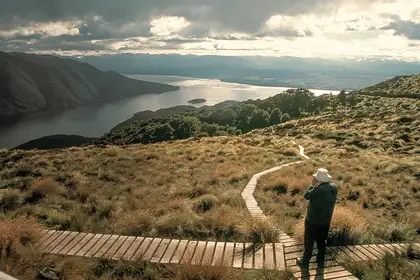
Professor Regina Scheyvens says continuing a business-as-usual approach to growing visitor numbers will have devastating consequences for the environment.
By Regina Scheyvens
New Zealand has been relatively immune to the strident protests about “overtourism” that have hit major European cities like Barcelona and Venice in recent years, but as a nation, we can no longer afford to be complacent about visitor growth.
Overtourism is now a serious issue in many parts of the world. Concerns have been raised from Amsterdam to Dubrovnik about crowded parks, pressure on public facilities, rising rents and noise pollution. This has driven residents to march the streets in anti-tourism protests.
The Parliamentary Commissioner for the Environment’s report released today (December 18) into the environmental consequences of projected tourism growth is timely, considered and comprehensive.
The report identifies six main areas of pressure including the number of visitors, infrastructure development, loss of biodiversity and degrading water quality. It signals that, as a nation, we can no longer be complacent and that a business-as-usual approach to growing our tourism sector will have devastating consequences for the natural environment, New Zealand’s major drawcard for visitors.
The report quite rightly recognises that trading on the integrity and wellbeing of our natural environment should not be an option and that trade-offs will need to be made between growing tourism numbers and creating quality jobs, while trying to protect the environment.
As a nation, we need to view tourism in a holistic, integrated way in terms of how it aligns with broader national goals, considering ways tourism can protect the environment while enhancing the wellbeing of New Zealanders, both those working in the industry and those living in the places that tourists like to visit?
A useful approach is taken by organisations like Auckland Tourism, Events and Economic Development (ATEED), the Central Economic Development Agency and its Wellington regional equivalent, which aim to make Auckland, Manawatu and Wellington great places to live, work and visit.
Current government policies of geographical and seasonal dispersal of visitors are a useful step in the right direction. In weighing up priorities, the wellbeing of our environmentally blessed but economically challenged regions, including Northland and Westland, should be prioritised. Using the International Visitor Conservation and Tourism Levy to invest in these places, and the people living there, is critical.
While the report quite rightly notes that domestic tourists have a big impact too, our carbon footprint is typically far smaller because we are not taking long-haul flights. Kiwis also tend to travel to more places that are off the tourism map, and support locally-owned businesses like motels and camping grounds, providing enduring economic impact. A campaign to encourage more domestic tourism, like the iconic 1980s advertisement “Don’t leave town till you’ve seen the country”, could result in an increasing number of New Zealanders choosing to stay for holidays, rather than fly overseas. This would also cut down on our overall emissions.

Professor Regina Scheyvens.
Funding increase required
Fundamentally, the Department of Conservation needs more resources to re-design tourist experiences in conservation areas of New Zealand, providing better infrastructure in high-use, short-walk areas like boardwalks, to minimise environmental damage, and dispersing more adventurous tourists to lesser-used, but still well-serviced, trails and locations.
I believe future policy should be informed more deeply by Māori values. A Māori tourism operator on the Whanganui River Hayden Potaka said to me that he believes every boat taking tourists on that river - whose spiritual significance is now recognised through the river being granted the legal status of a person - should have a cultural navigator. Their role would be to better inform tourists of the intertwined cultural, spiritual and natural elements of that unique environment, and to ensure respectful behaviours from visitors.
When it comes to protecting and safe-guarding our natural assets like iconic sites and walks, it is likely that further quotas will be needed. For example, charging $20 per adult during the peak season and putting a cap on the total number of visitors each day for popular walks like the Tongariro Crossing or Roy’s Peak, could help to control the impact.
However, with any quota system, securing access for New Zealanders – especially those of low economic means – is important. There needs to be a sense that we, as New Zealanders, are all kaitiaki (guardians) of our precious natural environment and that can only come if we all have the chance to learn about and enjoy experiences in nature.
Regina Scheyvens is a Professor of Development Studies in Massey University’s School of People, Environment and Planning.